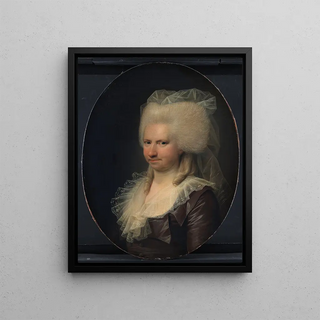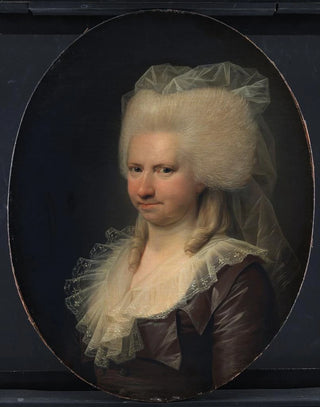Art print | Charlotte Sophie Gerner with Rasch Henrik Gerner's wife - Jens Juel


View from behind

Frame (optional)
The painting "Charlotte Sophie Gerner with Rasch Henrik Gerner's wife" by Jens Juel, created at the end of the 18th century, is a work that transcends mere portraiture to become a true window into the era. This canvas, rich in detail and emotion, immerses us in the Danish bourgeois universe of the time, where daily life intertwines with deeper concerns. Juel, master of the art print, manages to capture not only the physical features of his subjects but also their essence, character, and the relationships that connect them. In this work, the dignity and refinement of the characters are revealed through subtle expressions and delicate postures, inviting the viewer to ponder their personal stories and their place in society.
Style and uniqueness of the work
Jens Juel's style is distinguished by his ability to combine realism and idealization. In "Charlotte Sophie Gerner with Rasch Henrik Gerner's wife," the composition is carefully orchestrated, with each element designed to create a harmonious balance. The colors, with their soothing softness, evoke an atmosphere of serenity and refinement. The drapery of the clothing, beautifully rendered, testifies to exceptional craftsmanship, while the faces of the two women, imbued with a certain gravity, reveal rare psychological depth. The subtly diffused light accentuates the reliefs of the forms and gives the entire piece an almost tactile dimension. This art print does not merely depict figures; it tells a story, that of two women rooted in their time, but whose timeless emotions make them universal.
The artist and his influence
Jens Juel, an emblematic figure of Danish painting, left his mark on his era through his innovative approach to portraiture. Born in 1745, he established himself on the European artistic scene, notably through his stays in Paris, where he was influenced by the great masters of classicism. Juel managed to incorporate these influences while developing a personal style that is uniquely his own. His ability to capture the psychology of his subjects inspired many artists, both in Scandinavia and beyond. By focusing on

Matte finish

View from behind

Frame (optional)
The painting "Charlotte Sophie Gerner with Rasch Henrik Gerner's wife" by Jens Juel, created at the end of the 18th century, is a work that transcends mere portraiture to become a true window into the era. This canvas, rich in detail and emotion, immerses us in the Danish bourgeois universe of the time, where daily life intertwines with deeper concerns. Juel, master of the art print, manages to capture not only the physical features of his subjects but also their essence, character, and the relationships that connect them. In this work, the dignity and refinement of the characters are revealed through subtle expressions and delicate postures, inviting the viewer to ponder their personal stories and their place in society.
Style and uniqueness of the work
Jens Juel's style is distinguished by his ability to combine realism and idealization. In "Charlotte Sophie Gerner with Rasch Henrik Gerner's wife," the composition is carefully orchestrated, with each element designed to create a harmonious balance. The colors, with their soothing softness, evoke an atmosphere of serenity and refinement. The drapery of the clothing, beautifully rendered, testifies to exceptional craftsmanship, while the faces of the two women, imbued with a certain gravity, reveal rare psychological depth. The subtly diffused light accentuates the reliefs of the forms and gives the entire piece an almost tactile dimension. This art print does not merely depict figures; it tells a story, that of two women rooted in their time, but whose timeless emotions make them universal.
The artist and his influence
Jens Juel, an emblematic figure of Danish painting, left his mark on his era through his innovative approach to portraiture. Born in 1745, he established himself on the European artistic scene, notably through his stays in Paris, where he was influenced by the great masters of classicism. Juel managed to incorporate these influences while developing a personal style that is uniquely his own. His ability to capture the psychology of his subjects inspired many artists, both in Scandinavia and beyond. By focusing on






